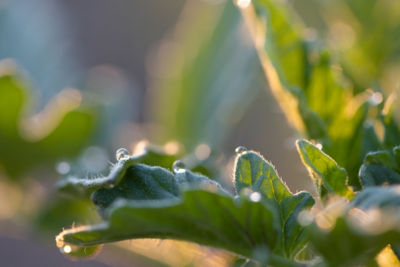Click here to download a PDF version of this spotlight.
» Powdery mildew can cause significant yield reductions in peppers.
» The fungal pathogen has a wide host range and is spread by wind-blown spores.
» A variety of methods are available to manage powdery mildew on peppers.
SYMPTOMS
The initial symptoms of powdery mildew on peppers are a powdery-white fungal growth on the undersides of leaves with light-green to yellow blotches on the upper leaf surfaces (Figure 1). These areas turn brown with time, and the affected areas coalesce, causing a general yellowing of the entire leaf. The outer edges of leaves may curl upward. The older leaves lower in the canopy are usually infected first and show symptoms before the younger leaves.1
 Figure 1. The powdery mildew fungus sporulates on the undersides of leaves.
Figure 1. The powdery mildew fungus sporulates on the undersides of leaves.
Infected leaves drop from the plant prematurely. This loss of photosynthetic leaf area slows plant growth and fruit development. The defoliation also exposes fruit to direct sunlight, which can lead to sunscalding of the fruit (Figure 2).
DISEASE CYCLE AND CONDITIONS
Leveillula taurica, the fungus that causes powdery mildew on pepper, is an obligate parasite that needs living host tissue to grow and reproduce. The fungus survives during periods between pepper crops on alternate host species. L. taurica is somewhat unusual for a powdery mildew fungus in that it has a very wide host range. The pathogen can infect over 700 species of plants in 59 different families. Susceptible crop and horticultural plants include alfalfa, artichoke, cotton, eggplant, onion, tomato, mesquite, and monkey-flower. Susceptible weed species include sow-thistle, cocklebur, groundsel, desert tobacco, and shepherd’s purse. There appears to be some host specificity among isolates of the pathogen as individual isolates may be able to infect some reported host species but not others.1,2
The pathogen is disseminated as spores carried in the wind. Powdery mildew occurs on peppers in both humid and arid environments, as the spores can germinate over the range of relative humidity levels from zero to 100%. However, the highest rates of spore germination occur when nighttime humidity levels are between 90% and 95% and daytime levels are above 85%. The spores can germinate at temperatures from 50°F to 95°F, with the optimum temperature range is from 60°F to 77°F.
 Figure 2. Defoliation from powdery mildew exposes fruit to direct sunlight resulting in sunscald damage.
Figure 2. Defoliation from powdery mildew exposes fruit to direct sunlight resulting in sunscald damage.
Once germination and infection have occurred, disease development is favored by warm days and cool nights, with the most severe disease levels occurring with daytime temperatures near 86°F and nighttime temperatures below 77°F.1 Disease development is suppressed at temperatures above 95°F.2 While infection is highest under humid conditions, defoliation is favored by drier conditions. Therefore, the impact of the disease is most severe when humidity levels change from humid to dry.1,3
EFFECTS ON YIELD
An outbreak of powdery mildew on peppers in Ontario in 2005 infected large numbers of fields, with one study finding the disease in 10 of the 12 fields that were surveyed. In six of those 10 fields, powdery mildew was found on 100% of the evaluated plants at moderate to severe levels.4 In the first report of powdery mildew on peppers in the Pacific Northwest in 2009, growers reported losses of up to 40%.5
Yield reductions from powdery mildew result, in part, from a loss of photosynthetic area that inhibits plant growth and fruit development (Table 1).6 Fewer flowers form on severely infected plants, and flowers may also drop off of infected plants. Additional losses come from sunscalding of the fruit.3
 Table 1. Effects of powdery mildew and fungicide treatment on pepper growth, photosynthesis, and yield.
Table 1. Effects of powdery mildew and fungicide treatment on pepper growth, photosynthesis, and yield.
The importance of the density of pepper foliage depends, somewhat, on the type of production and the region in which the peppers are being grown. Because of the growing conditions, peppers grown in the western U.S. require more dense canopies than do peppers grown in the southeastern part of the country. Therefore, a loss of leaves from powdery mildew may have more of an impact on production in the western U.S. growing areas.
Dense canopies are also more important for peppers being grown for fresh market sales, where large, well-formed fruit are required, as compared to peppers grown for processing, where smaller, irregular-shaped fruit can still be used. Also, the production of red fruit requires an additional 15 to 30 days in the field, as compared to green fruit production. A loss of leaves over this added time has a greater impact on the quality of fruit, especially the amount of sunscalding.
MANAGEMENT
With the wide host range of the pathogen and wind dispersal of the spores, crop rotation and management of nearby weed hosts may not provide an adequate level of control without using other means of control.1
Low light and high humidity favor the development of powdery mildew on peppers, so cultural practices that minimize these conditions can help lower disease severity. Select sites with well-drained soils and good air circulation. Adjust planting densities and row orientations to promote good air circulation and light penetration into the canopy. Avoid excessive fertilization that would result in overly dense canopies. In greenhouse production, increasing the temperature in the greenhouse can lower humidity levels and slow disease development.
A second control method for powdery mildew on peppers is the application of fungicides.2 Several fungicides are available for controlling powdery mildew on peppers (Table 2); however, products vary in their required pre-harvest interval (PHI), and some have crop rotation plant-back restrictions.7 Appropriate fungicide resistance management strategies should be used to prevent the development of fungicide-resistant strains of the pathogen.7
The effectiveness of the applications will depend on early detection and thorough coverage of the leaves. Applications should begin before symptoms appear, as the disease is difficult to control once it develops. The initial application should be based on when the disease typically shows up in the region.7,2 Spray volumes and pressure, in accordance with the label, must be sufficient to reach the lower leaves, including the undersides of leaves where infection occurs.1
There is variation among pepper varieties in their susceptibility to powdery mildew. Non-pungent types of peppers tend to have more tolerance to the disease than do more pungent types.1 Some resistance to powdery mildew is available in cultivars used in greenhouse production, but moderate to high levels of resistance are not currently available in cultivars used for field production. Genes for powdery mildew resistance have been identified, and resistant cultivars should soon be available.
 Table 2. Fungicides available for controlling pepper powdery mildew.7
Table 2. Fungicides available for controlling pepper powdery mildew.7
SOURCES
1 Goldberg, N. 2003. Powdery mildew. In Compendium of Pepper Diseases, Pernezny, K., Roberts, P., Murphy, J., and Goldberg, N. Editors. American Phytopathological Society.
2 Koike, S., Davis, R., and Subbarao, K. 2016. Peppers: Powdery mildew. UC IPM, UC Pest Management Guidelines. UC ANR Publication 3460.
3 Elad, Y., Messika, Y., Brand, M., David, D., and Sztejnberg, A. 2007. Effect of microclimate on Leveillula taurica powdery mildew of sweet pepper. Phytopathology 97:813-824.
4 Cerkauskas, R. Ferguson, G., and Banik, M. 2011. Powdery mildew (Leveillula taurica) on greenhouse and field peppers in Ontario – host range, cultivar response and disease management strategies, Canadian Journal of Plant Pathology, 33:4, 485-498.
5 Glawe, D., Barlow, T., Eggers, J., and Hamm, P. 2010. First report of powdery mildew caused by Leveillula taurica of field-grown sweet pepper in the Pacific Northwest. Online. Plant Health Progress, Doi: 10.1094/PHP-2007-0708-01-BR.
6 Karkanis, A., Bilalis, D., Efthimiadou, A., and Katsenios, N. 2012. Effects of field bindweed (Convolvulus arvensis L.) and powdery mildew [Leveillula taurica (Lev.) Arn.] on pepper growth and yield – Short communication. Hort. Sci. (Prague) 39:3, 135-138.
7 Egel, D., Foster, R., Maynard, E., Weller, S., Babadoost, M., Nair, A., Rivard, C., Kennelly, M., Hausbedk, M., Hutchinson, B., Eaton, T., Welty, C., and Miller, S. 2017. Midwest vegetable production guide for commercial growers 2017.
ADDITIONAL INFORMATION
For additional agronomic information, please contact your local seed representative. Developed in partnership with Technology, Development & Agronomy by Monsanto.
Individual results may vary, and performance may vary from location to location and from year to year. This result may not be an indicator of results you may obtain as local growing, soil and weather conditions may vary. Growers should evaluate data from multiple locations and years whenever possible. ALWAYS READ AND FOLLOW PESTICIDE LABEL DIRECTIONS. The recommendations in this article are based upon information obtained from the cited sources and should be used as a quick reference for information about powdery mildew on peppers. The content of this article should not be substituted for the professional opinion of a producer, grower, agronomist, pathologist and similar professional dealing with this specific crop.
SEMINIS DOES NOT WARRANT THE ACCURACY OF ANY INFORMATION OR TECHNICAL ADVICE PROVIDED HEREIN AND DISCLAIMS ALL LIABILITY FOR ANY CLAIM INVOLVING SUCH INFORMATION OR ADVICE. 170826161344 090617DME




